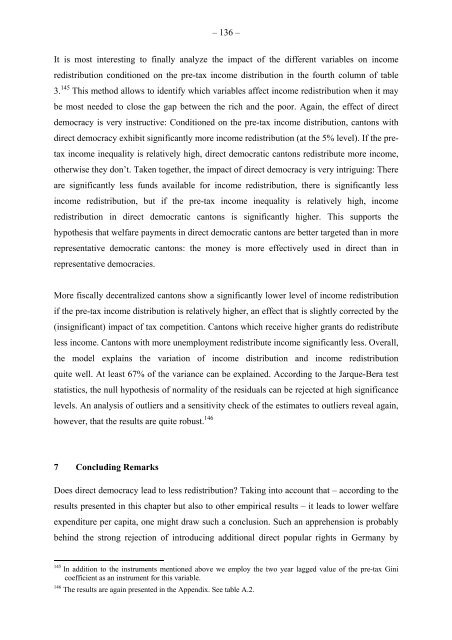The Impact of Direct Democracy on Society - Universität St.Gallen
The Impact of Direct Democracy on Society - Universität St.Gallen
The Impact of Direct Democracy on Society - Universität St.Gallen
- No tags were found...
Create successful ePaper yourself
Turn your PDF publications into a flip-book with our unique Google optimized e-Paper software.
– 136 –It is most interesting to finally analyze the impact <str<strong>on</strong>g>of</str<strong>on</strong>g> the different variables <strong>on</strong> incomeredistributi<strong>on</strong> c<strong>on</strong>diti<strong>on</strong>ed <strong>on</strong> the pre-tax income distributi<strong>on</strong> in the fourth column <str<strong>on</strong>g>of</str<strong>on</strong>g> table3. 145 This method allows to identify which variables affect income redistributi<strong>on</strong> when it maybe most needed to close the gap between the rich and the poor. Again, the effect <str<strong>on</strong>g>of</str<strong>on</strong>g> directdemocracy is very instructive: C<strong>on</strong>diti<strong>on</strong>ed <strong>on</strong> the pre-tax income distributi<strong>on</strong>, cant<strong>on</strong>s withdirect democracy exhibit significantly more income redistributi<strong>on</strong> (at the 5% level). If the pretaxincome inequality is relatively high, direct democratic cant<strong>on</strong>s redistribute more income,otherwise they d<strong>on</strong>’t. Taken together, the impact <str<strong>on</strong>g>of</str<strong>on</strong>g> direct democracy is very intriguing: <str<strong>on</strong>g>The</str<strong>on</strong>g>reare significantly less funds available for income redistributi<strong>on</strong>, there is significantly lessincome redistributi<strong>on</strong>, but if the pre-tax income inequality is relatively high, incomeredistributi<strong>on</strong> in direct democratic cant<strong>on</strong>s is significantly higher. This supports thehypothesis that welfare payments in direct democratic cant<strong>on</strong>s are better targeted than in morerepresentative democratic cant<strong>on</strong>s: the m<strong>on</strong>ey is more effectively used in direct than inrepresentative democracies.More fiscally decentralized cant<strong>on</strong>s show a significantly lower level <str<strong>on</strong>g>of</str<strong>on</strong>g> income redistributi<strong>on</strong>if the pre-tax income distributi<strong>on</strong> is relatively higher, an effect that is slightly corrected by the(insignificant) impact <str<strong>on</strong>g>of</str<strong>on</strong>g> tax competiti<strong>on</strong>. Cant<strong>on</strong>s which receive higher grants do redistributeless income. Cant<strong>on</strong>s with more unemployment redistribute income significantly less. Overall,the model explains the variati<strong>on</strong> <str<strong>on</strong>g>of</str<strong>on</strong>g> income distributi<strong>on</strong> and income redistributi<strong>on</strong>quite well. At least 67% <str<strong>on</strong>g>of</str<strong>on</strong>g> the variance can be explained. According to the Jarque-Bera teststatistics, the null hypothesis <str<strong>on</strong>g>of</str<strong>on</strong>g> normality <str<strong>on</strong>g>of</str<strong>on</strong>g> the residuals can be rejected at high significancelevels. An analysis <str<strong>on</strong>g>of</str<strong>on</strong>g> outliers and a sensitivity check <str<strong>on</strong>g>of</str<strong>on</strong>g> the estimates to outliers reveal again,however, that the results are quite robust. 1467 C<strong>on</strong>cluding RemarksDoes direct democracy lead to less redistributi<strong>on</strong>? Taking into account that – according to theresults presented in this chapter but also to other empirical results – it leads to lower welfareexpenditure per capita, <strong>on</strong>e might draw such a c<strong>on</strong>clusi<strong>on</strong>. Such an apprehensi<strong>on</strong> is probablybehind the str<strong>on</strong>g rejecti<strong>on</strong> <str<strong>on</strong>g>of</str<strong>on</strong>g> introducing additi<strong>on</strong>al direct popular rights in Germany by145 In additi<strong>on</strong> to the instruments menti<strong>on</strong>ed above we employ the two year lagged value <str<strong>on</strong>g>of</str<strong>on</strong>g> the pre-tax Ginicoefficient as an instrument for this variable.146 <str<strong>on</strong>g>The</str<strong>on</strong>g> results are again presented in the Appendix. See table A.2.
















